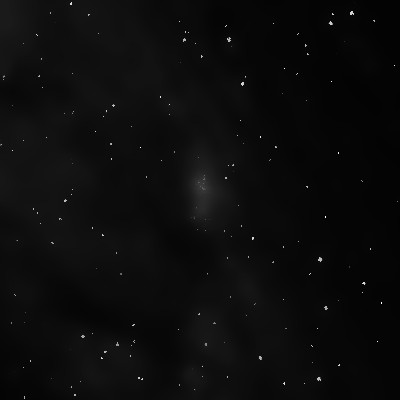
William Herschel discovered NGC 206 = H V-36 = h45 on 17 Oct 1786 (sweep 613) and recorded "vF, vL, mE, about 20' long nearly in the meridian, or a little from np to sf." John Herschel simply called it "a very large space filled with neb.”
E.E. Barnard independently discovered NGC 206 in 1883 and assumed it was new. On 14 Sep 1885 he reported [AN 2687], "about two years ago, I found with my 5-inch refractor, a moderate size nebula involved with the extreme preceding end of the Great Nebula in Andromeda. I have now confirmed the observation with the 6-inch Cooke Equatorial and as I can find no record of such nebula I suppose it is new." Barnard quickly caught his mistake and credited Herschel the next month [AN 2691]. Interestingly, Barnard also reported discovery of the M31 association A54 on the opposite end of M31, though for some reason Dreyer didn’t assign this object a NGC designation.
200/250mm - 8" (12/6/80): very faint, moderately large, elongated N-S, low surface brightness patch near the SW end of M31.
400/500mm - 17.5" (8/18/93): fairly faint, fairly large, elongated 5:2 N-S, 4.0'x1.6', low and uneven surface brightness. A few very faint stars are just visible over surface including a brighter star at the south tip. Located 40' SW of the core of M31. This is the huge star cloud at the SW end of M31.
600/800mm - 24" (8/25/19): quite prominent, very large elongated patch, extending 4'x2' N-S. A number of faint stars were easily seen superimposed. A brighter, narrow "spine" stands out well with the general star cloud. NGC 206 can be traced further SSW, where it merges with Association 79, a very large 6'x2' cloud of lower surface brightness oriented SSW-NNE. Association 80 is 3' patch directly south of NGC 206 by 7' and has 3 brighter stars superimposed on the north side. This patch also includes C107, a 5" open cluster on its south side.
900/1200mm - 48" (11/1/13): Using Jimi Lowrey’s 48-inch f/4, we carefully examined the large association NGC 206 for resolved stars using the finder chart in Stephen Odewahn's 1987 study "A photometric survey of the rich OB association NGC 206 in M31”. I assumed using a labeled photographic chart it would not be difficult to identify individual stars, but his chart failed to capture the range in visual brightness of the Milky Way and cluster stars. As a result I had to carefully verify small patterns of stars (triangle, quadrilaterals, etc.) several times to feel confident of the identifications. After several minutes of observation, I had identified the 6 or 7 brightest members down to V = 17.6, as well as the superimposed Milky Way stars. The brightest “star" (Odewahn #12 at V = 16.1) at the north edge was relatively prominent, but most were in the mag 17-17.5 range.
Finally, I stopped carefully scrutinizing individual stars, relaxed my eyes and just gazed at the entire star cloud with averted vision. I was startled that in moments of good seeing, roughly 20 additional extremely faint stars popped in and out of view, mimicking the appearance of a dense open cluster or partially resolved globular cluster! Based on photometry in the paper, the magnitudes of the resolved stars extended down to approximately V = 18.3-18.4. The cloud, itself, was quite irregular and split up into several slightly brighter patches.
Checking journal articles afterwards, I found that Odewahn #12 (= BH05) was not a single star but was listed as a globular cluster candidate M31GC J004030+404530) in Barmby & Huchra’s 2001 paper " M31 Globular Clusters in the HST Archive: I. Cluster Detection and Completeness”. But the 2010 paper "A Photometric catalog of 77 newly-recognized star clusters in M31” by Paul Hodge described the results of an HST WFPC2 search for star clusters in active star-formation regions of M31. BH05 was reclassified as a luminous and massive young cluster with an unusually elliptical shape. In addition, Odewahn’s #40 and #112 (and perhaps others) are also clumps of stars or clusters, but visually were essentially stellar.
Notes by Steve Gottlieb